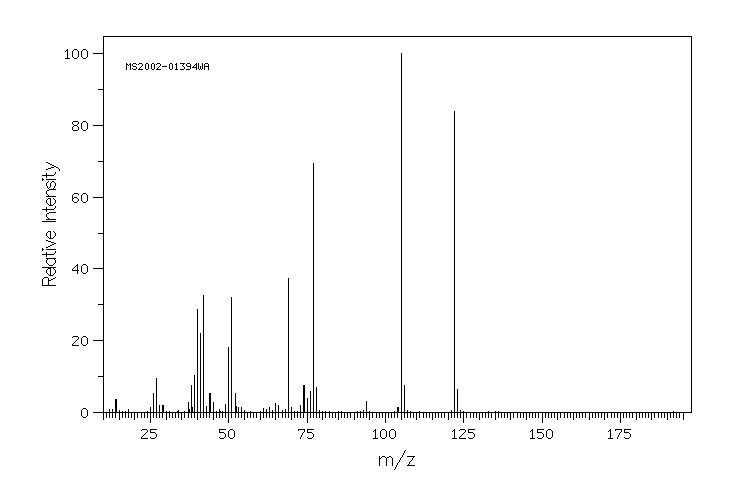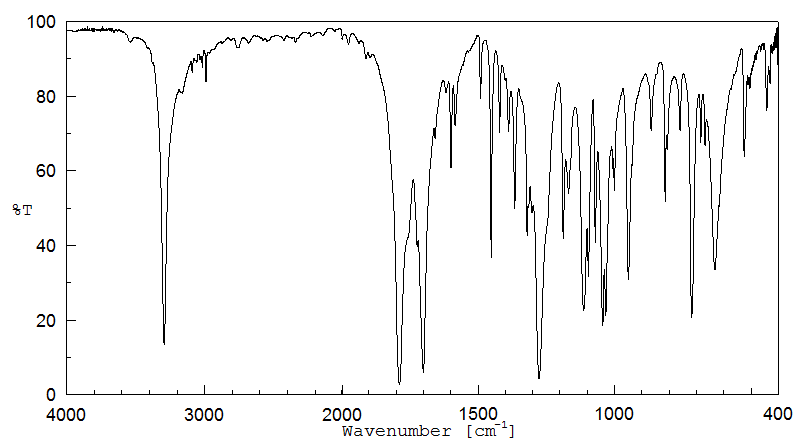4-benzoyloxy-2-azetidinone | 129329-84-6
中文名称
——
中文别名
——
英文名称
4-benzoyloxy-2-azetidinone
英文别名
(4-oxoazetidin-2-yl) benzoate
CAS
129329-84-6
化学式
C10H9NO3
mdl
MFCD00012317
分子量
191.186
InChiKey
HJJGOOONOIFDRH-UHFFFAOYSA-N
BEILSTEIN
——
EINECS
——
-
物化性质
-
计算性质
-
ADMET
-
安全信息
-
SDS
-
制备方法与用途
-
上下游信息
-
文献信息
-
表征谱图
-
同类化合物
-
相关功能分类
-
相关结构分类
计算性质
-
辛醇/水分配系数(LogP):1.4
-
重原子数:14
-
可旋转键数:3
-
环数:2.0
-
sp3杂化的碳原子比例:0.2
-
拓扑面积:55.4
-
氢给体数:1
-
氢受体数:3
上下游信息
反应信息
-
作为反应物:描述:4-benzoyloxy-2-azetidinone 在 三乙胺 、 三甲基膦 作用下, 以 二氯甲烷 、 甲苯 为溶剂, 反应 13.17h, 生成 Benzoic acid 3-oxo-1,3-dihydro-2H-2a,8-diaza-cyclobuta[b]naphthalen-2-yl ester参考文献:名称:The First Aza-Wittig Reaction of the β-Lactam Carbonyl Group摘要:DOI:10.1055/s-1998-1920
-
作为产物:描述:过氧化苯甲酸叔丁酯 在 ammonium cerium(IV) nitrate 、 copper(II) octanoate 作用下, 以 水 、 乙腈 、 苯 为溶剂, 反应 6.5h, 生成 4-benzoyloxy-2-azetidinone参考文献:名称:Easton, Christopher J.; Love, Stephen G.; Wang, Peng, Journal of the Chemical Society. Perkin transactions I, 1990, # 2, p. 277 - 282摘要:DOI:
文献信息
-
HPLC enantioseparation on a homochiral MOF–silica composite as a novel chiral stationary phase作者:Koichi Tanaka、Toshihide Muraoka、Yasuhiro Otubo、Hiroki Takahashi、Atsushi OhnishiDOI:10.1039/c5ra26520g日期:——frontier in the development of chiral stationary phases for chromatographic enantioseparation involves homochiral metal–organic frameworks (MOFs). Using enantiopure (R)-2,2′-dihydroxy-1,1′-binaphthalene-6,6′-dicarboxylic acid as a starting material, we prepared three homochiral MOFs that were further used as chiral stationary phases for high-performance liquid chromatography to separate the enantiomers
-
Separating agent for optical isomers申请人:Kawata Yuki公开号:US08859757B2公开(公告)日:2014-10-14A separating agent for optical isomers that uses a polysaccharide derivative provided by replacing all or a portion of the hydrogen atoms on the hydroxyl groups present in a polysaccharide with two specific atomic groups that act on optical isomers targeted for separation in an optical resolution, wherein the sum of the average introduction ratios of specific terminal substituents in these atomic groups is greater than 3.0 per monosaccharide unit.
-
Characteristic and complementary chiral recognition ability of four recently developed immobilized chiral stationary phases based on amylose and cellulose phenyl carbamates and benzoates作者:Takafumi Onishi、Takunori Ueda、Kenichi Yoshida、Kosuke Uosaki、Hiroyuki Ando、Ryota Hamasaki、Atsushi OhnishiDOI:10.1002/chir.23446日期:2022.7various immobilized chiral stationary phases (CSPs) have been developed. The immobilized CSPs have opened up possibilities not only maintaining the high chiral recognition abilities as well as corresponding coated ones but also affording high durability to various mobile phase. This report directed to investigate enantioseparation of recently launched four immobilized CSPs with cellulose and amylose迄今为止,已经开发了各种固定化手性固定相 (CSP)。固定化的 CSP 不仅为保持高手性识别能力和相应的涂层能力开辟了可能性,而且为各种流动相提供了高耐久性。本报告旨在研究在正相液相色谱条件下最近推出的四种具有纤维素和直链淀粉骨架的固定化 CSP 的对映体分离。将它们的手性识别能力与之前开发的六种固定化 CSP 进行了比较。特别是,我们专注于手性识别的互补性。其中,直链淀粉三(3-氯-5-甲基苯基氨基甲酸酯)CSP,即CHIRALPAK IG,对各种外消旋体显示出显着的手性识别能力。正如预期的那样,研究的固定化 CSP 对各种流动相具有显着的耐久性,而相应的涂层 CSP 由于不可逆的降解而无法运行。利用不受限制的溶剂相容性,一些外消旋体的手性分离选择性得到改善。
-
Integrin antagonists申请人:——公开号:US20010044535A1公开(公告)日:2001-11-22This invention relates to novel heterocycles which are useful as antagonists of the &agr; v &bgr; 3 integrin, the &agr; 2b &bgr; 3 integrin, and related cell surface adhesive protein receptors, to pharmaceutical compositions containing such compounds, processes for preparing such compounds, and to methods of using these compounds, alone or in combination with other therapeutic agents, for the inhibition of cell adhesion, the treatment of angiogenic disorders, inflammation, bone degradation, cancer metastasis, diabetic retinopathy, thrombosis, restenosis, macular degeneration, and other conditions mediated by cell adhesion and/or cell migration and/or angiogenesis.这项发明涉及一种新颖的杂环化合物,可用作αvβ3整合素、α2bβ3整合素以及相关细胞表面粘附蛋白受体的拮抗剂,还涉及含有这些化合物的药物组合物、制备这些化合物的方法,以及使用这些化合物单独或与其他治疗剂联合用于抑制细胞粘附、治疗血管生成障碍、炎症、骨降解、癌症转移、糖尿病性视网膜病变、血栓形成、再狭窄、黄斑变性以及其他通过细胞粘附和/或细胞迁移和/或血管生成介导的疾病的方法。
-
BETA LACTAMS AS ANTIPROLIFERATIVE AGENTS申请人:——公开号:US20020082250A1公开(公告)日:2002-06-27This invention relates to a method of treating or reducing cell proliferation in a mammal in need thereof which comprises administering to said mammal an effective CoA-independent transacylase (CoA-IT) inhibiting amount of a compound of formula (I), wherein the variables of Y, X, m, R 3, R 4, R 10, R 20, R 5, R 6 and R 7 are defined in the specification. FIG. 3 demonstrates the ability of SB216754, ((3S,4R)-4-(isobutenyloxy)-3-triphenylmethylamino)azetidin-2-one) to decrease the viability of HL-60 cells.
表征谱图
-
氢谱1HNMR
-
质谱MS
-
碳谱13CNMR
-
红外IR
-
拉曼Raman
-
峰位数据
-
峰位匹配
-
表征信息
同类化合物
(6R,7R)-7-苯基乙酰胺基-3-[(Z)-2-(4-甲基噻唑-5-基)乙烯基]-3-头孢唑啉-4-羧酸二苯甲基酯
顺式-4-(2,2-二甲氧基乙基)-3-邻苯二甲酰-2-氮杂环丁酮
顺式-3-氨基-1-(2,4-二甲氧基苄基)-4-甲氧羰基-2-氮杂环丁酮
顺式-1-(对甲苯基)-3-苄氧基-4-(对茴香基)-氮杂环丁烷-2-酮
顺式-1,4-二苯基-3-(甲基苯基氨基)-2-氮杂环丁酮
青霉酰聚赖氨酸
青霉素钾
青霉素钠
青霉素酶液体
青霉素杂质F氢化物
青霉素杂质C
青霉素亚砜酯(GESO)
青霉素V二苄乙二胺
青霉素G衍生物
青霉素G甲酯
青霉素G甲酯
青霉素G-D7
青霉素 V 钠
阿那白滞素
阿莫西林钠
阿莫西林三水合物
阿莫西林
阿立必利D5
阿度西林
铜(2+)酞菁-29,30-二负离子-2-(二甲氨基)乙醇(1:1:1)
钾(2S,5R,6R)-6-[[2-[(E)-3-氯丁-2-烯基]巯基乙酰基]氨基]-3,3-二甲基-7-氧代-4-硫杂-1-氮杂双环[3.2.0]庚烷-2-羧酸酯
钠6-[[3-(2-氯-6-氟苯基)-5-甲基1,2-恶唑-4-羰基]氨基]-3,3-二甲基-7-氧代-4-硫杂-1-氮杂双环[3.2.0]庚烷-2-羧酸盐水合物
钠(6S,7R)-3-(羟基甲基)-7-甲氧基-8-氧代-7-[(2-噻吩基乙酰基)氨基]-5-硫杂-1-氮杂双环[4.2.0]辛-2-烯-2-羧酸酯
钠(6R,7R)-7-[[(2Z)-2-(2-氨基-1,3-噻唑-4-基)-2-甲氧基亚氨基乙酰基]氨基]-8-氧代-3-[(2S)-四氢呋喃-2-基]-5-硫杂-1-氮杂双环[4.2.0]辛-2-烯-2-羧酸酯
钠(2S,5R,6R)-6-[(2-叠氮基-2-苯基乙酰基)氨基]-3,3-二甲基-7-氧代-4-硫杂-1-氮杂双环[3.2.0]庚烷-2-羧酸盐
酞氨西林
赖氨酸氯尼辛
萘夫西林钠
萘夫西林钠
萘夫西林杂质
苯磺酸,2-[(2-羟基-1-萘基)偶氮]-5-甲基-,盐(2:1)钡
苯甘孢霉素亚砜
苯氧乙基青霉素钾
苯并[b]噻吩-3-羧酸,2-[3-氯-2-(4-硝基苯基)-4-羰基-1-吖丁啶基]-4,5,6,7-四氢-,乙基酯
苯唑西林钠
苯唑西林杂质1
舒巴坦杂质19
舒他西林
脱乙酰基戊二酰 7-氨基头孢烷酸
脱乙酰基头孢噻肟
肟莫南
羰苄西林苯酯钠
美罗培南钠盐
美罗培南
美洛培南








